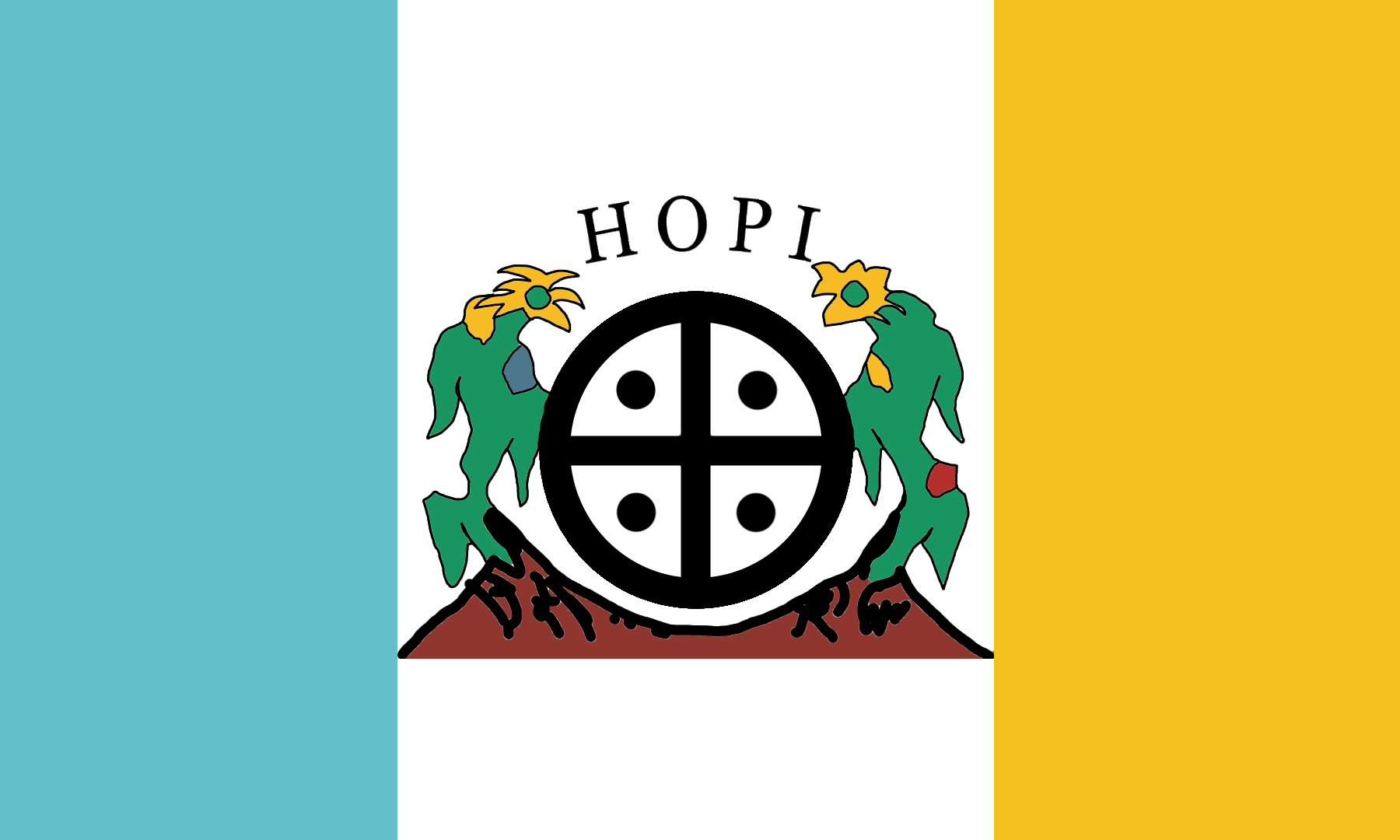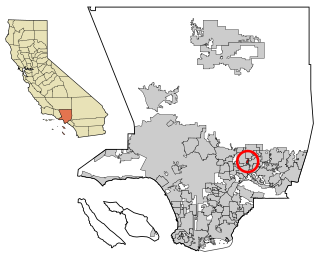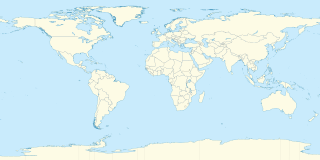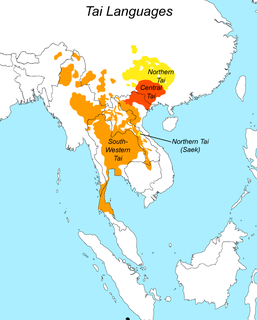
A village is a clustered human settlement or community, larger than a hamlet but smaller than a town, with a population ranging from a few hundred to a few thousand. Though villages are often located in rural areas, the term urban village is also applied to certain urban neighborhoods. Villages are normally permanent, with fixed dwellings; however, transient villages can occur. Further, the dwellings of a village are fairly close to one another, not scattered broadly over the landscape, as a dispersed settlement.

The Hopi are a Native American tribe who primarily live on the Hopi Reservation in northeastern Arizona. As of the 2010 census, there were 19,338 Hopi in the United States. The Hopi Tribe is a sovereign nation within the United States and has government-to-government relations with the United States federal government. Particular villages retain autonomy under the Hopi Constitution and Bylaws. The Hopi language is one of 30 in the Uto-Aztecan language family. The majority of Hopi people are enrolled in the Hopi Tribe of Arizona but some are enrolled in the Colorado River Indian Tribes. The Hopi Reservation covers a land area of 2,531.773 sq mi (6,557.26 km2).

Mayflower Village is a census-designated place (CDP) in the San Gabriel Valley, in Los Angeles County, California, United States. The population was 5,515 at the 2010 census, up from 5,081 at the 2000 census. The ZIP Codes serving the community are 91006, which is served by Arcadia and 91016, which is served by Monrovia.

Alaska Natives or Alaskan Natives are indigenous peoples of Alaska, United States and include: Iñupiat, Yupik, Aleut, Eyak, Tlingit, Haida, Tsimshian, and a number of Northern Athabaskan cultures. They are often defined by their language groups. Many Alaska Natives are enrolled in federally recognized Alaska Native tribal entities, who in turn belong to 13 Alaska Native Regional Corporations, who administer land and financial claims.

The Pima are a group of Native Americans living in an area consisting of what is now central and southern Arizona. The majority population of the surviving two bands of the Akimel O'odham are based in two reservations: the Keli Akimel Oʼotham on the Gila River Indian Community (GRIC) and the On'k Akimel O'odham on the Salt River Pima-Maricopa Indian Community (SRPMIC).

The Fremont culture or Fremont people is a pre-Columbian archaeological culture which received its name from the Fremont River in the U.S. state of Utah, where the culture's sites were discovered by local indigenous peoples like the Navajo and Ute. In Navajo culture, the pictographs are credited to people who lived before the flood. The Fremont River itself is named for John Charles Frémont, an American explorer. It inhabited sites in what is now Utah and parts of Nevada, Idaho and Colorado from AD 1 to 1301. It was adjacent to, roughly contemporaneous with, but distinctly different from the Ancestral Pueblo peoples located to their south.

The Algonquian are one of the most populous and widespread North American native language groups. Today, thousands of individuals identify with various Algonquian peoples. Historically, the peoples were prominent along the Atlantic Coast and into the interior along the Saint Lawrence River and around the Great Lakes. This grouping consists of the peoples who speak Algonquian languages.
The Adi people are one of the most populous groups of indigenous peoples in the Indian state of Arunachal Pradesh. A few thousand are also found in the Tibet Autonomous Region where they are called the Lhoba together with some of the Mishmi people.

Širvintos District Municipality is a municipality in Lithuania, it is in territory of Vilnius County and its capital is Širvintos.

Alawalpur is a town and a municipal council in Jalandhar district in the state of Punjab, India. Alawalpur is named after Alawal Khan, a Pathan who ruled the area during the time of Sandhanwalia Jat ruler Maharajah Ranjit Singh. Sardar Himmat Singh Jallewalia a Bains Jat Sardar, a general in Ranjit Singh's army, later conquered Alawalpur. His descendants still live in a fort located at the center of the city.

Wawanesa is an unincorporated urban community in the Municipality of Oakland – Wawanesa within the Canadian province of Manitoba that held village status prior to January 1, 2015. It is the birthplace of The Wawanesa Mutual Insurance Co.

Blue Zones are regions of the world where Dan Buettner claims people live much longer than average. The term first appeared in his November 2005 National Geographic magazine cover story, "The Secrets of a Long Life". Buettner identified five regions as "Blue Zones" : Okinawa (Japan); Sardinia (Italy); Nicoya ; Icaria (Greece); and among the Seventh-day Adventists in Loma Linda, California. He offers an explanation, based on data and first hand observations, for why these populations live healthier and longer lives than others.

Parshuram is an upazila of Feni District in the Division of Chittagong, in southeast Bangladesh.

Tarpey Village is a census-designated place in Fresno County, California, between Fresno and Clovis, 2 miles (3.2 km) south of the latter, near Tarpey. Tarpey village falls within the Clovis Unified School District. It lies at an elevation of 351 ft (107 m). At the 2010 census, the population was 3,888.

Kitselas Canyon, also Kitsalas Canyon is a stretch of the Skeena River in northwestern British Columbia, Canada, between the community of Usk and the Tsimshian community of Kitselas. It was a major obstacle to steamboat travel on the Skeena River.

Simao District is a district under the jurisdiction of Pu'er City, Yunnan Province, China. It is the seat of Puer Prefecture. Formerly both Simao and the surrounding region of Pu'er prefecture played a major role in the historic tea horse trade between Yunnan, Tibet and India, with Simao acting as the southern terminus or starting point for the transport of tea by mule caravan north to Dali, Lijiang and Lhasa. Tea remains a central crop and product of the region.

Village People are an American disco group best known for their on-stage costumes, catchy tunes, and suggestive lyrics. The group was originally formed by French producers Jacques Morali, Henri Belolo and lead singer Victor Willis following the release of the debut album Village People, which targeted disco's largely gay audience. The group's name refers to New York City's Greenwich Village, at the time known for its large gay population. The characters were a symbolic group of American masculinity and macho gay-fantasy personas.

Sugarloaf Village is a census-designated place (CDP) in Tulare County, California. Sugarloaf Village sits at an elevation of 5,171 feet (1,576 m). The 2010 United States census reported Sugarloaf Village's population was 10.

Tai people refers to the population of descendants of speakers of a common Tai language, including sub-populations that no longer speak a Tai language. There is a total of about 93 million people of Tai ancestry worldwide, with the largest ethnic groups being Dai, Thais, Isan, Shan, Lao, Ahom, and Northern Thai peoples.
Kucong, or Lahlu, is a Loloish language of Yunnan and Vietnam. In Vietnam, the speakers' autonym is, and are also known as the La Hủ Na 'Black Lahu'. It is very closely related to Lahu.
















